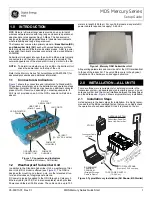
Input of analog composite PAL-M signals
You can input analog composite PAL-M signals to connectors
1
and
3
. When the cable is connected to connectors
2
and
4
, the 75-ohm termination of connectors
1
and
3
is
automatically released and you can obtain the loop-through
output from connectors
2
and
4
. Even if you do not wish to
use loop-through output, you need not attach the 75-ohm
termination to connectors
2
and
4
.
Specifications
General
Power requirements
+5 V, ±6 V
Power consumption
3 W
Operating conditions
Temperature
0°C to 35°C (32°F to 95°F)
Optimum temperature
20°C to 30°C (68°F to 86°F)
Humidity
0% to 90% (no condensation)
Pressure
700 hPa to 1060 hPa
Storage and transport conditions
Temperature
–10°C to 40°C (14°F to 104°F)
Humidity
0% to 90% (no condensation)
Pressure
700 hPa to 1060 hPa
Maximum external dimensions
25
×
162
×
122 mm
(1
×
6
1
/
2
×
4
7
/
8
inches)
(1-slot size)
Mass
270 g (10 oz)
Input/output connectors
Analog composite PAL-M signals
BNC
×
2, high impedance, with loop-through output and 75-
ohm automatic termination
Signal characteristics
Analog composite, PAL-M signals
Signal level
Analog composite
1 Vp-p +3 dB/–6 dB
Luminance signal
Frequency characteristics
Analog composite
Monochrome signal:
50 Hz to 6 MHz ±2 dB
Color signal: –30 dB relative to
subcarrier frequency
Chrominance signals
Demodulation axis
R–Y/B–Y
Subcarrier synchronization range
±200 Hz min.
Design and specifications are subject to change without notice.
Installing the Input Adaptor
Note
Disconnect the AC power plug before installing or removing
adaptors.
1
Remove the cover of an input option slot on the rear panel
of your video monitor.
2
Insert the adaptor.
3
Push the adaptor in until it is firmly seated in the
connector inside your video monitor.
4
Tighten the both screws to retain the adaptor.
Cover of an input
option slot




















